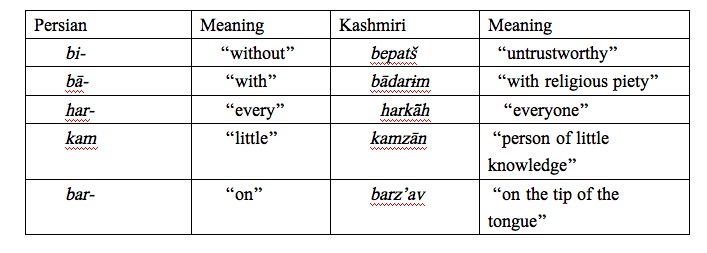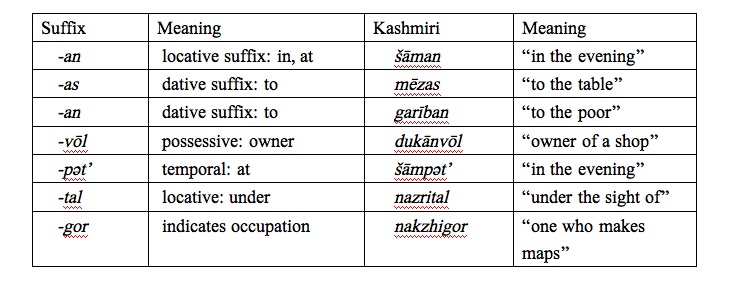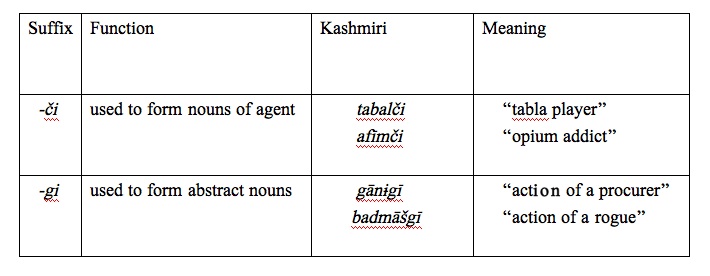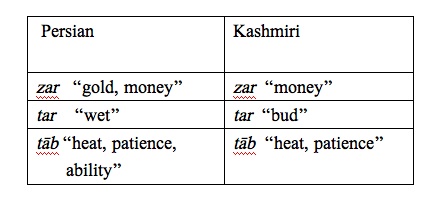KASHMIR
iv. Persian Elements in Kashmiri
This entry discusses the nature and extent of Persian influence on the Kashmiri language.
The influence of one language on another primarily takes place as a result of linguistic contact. It is always the dominant language that influences another language or languages on different linguistic and literary levels. Main contacts between Kashmir and Persia were both political and cultural. Islam entered the valley of Kashmir long before the period of the Muslim rule in Kashmir. Islamic missionaries and military adventurers from Persia came into Kashmir and preached the doctrine and teachings of Islam to the people. Thus, “Islam entered the valley not as a result of foreign invasion, but by a coup d’etat from within the country” (Bamzai, p. 422). Under the prevailing socio-political situation, it was not difficult for the common masses to embrace the new faith, Islam, which was preached by the Sufis on the grounds of social and religious humanism.
With the establishment of Muslim rule in Northwest India towards the middle of the 11th century, Perso-Arabic words made their way into native Indian vocabulary of the languages spoken at that time. Kashmir is said to have had cultural and trade relations with Persia from ancient times, but the influence of the Persian language and culture did not dominate until the introduction of Islam during the middle of the 14th century. The pace of Perso-Arabic influence in the valley was accelerated with the immigration of Syeds (sayyeds), nobles, and other scholars from Persia and Central Asia. Persian began to be studied in earnest by Kashmiri scholars in the educational institutions founded by the rulers and presided over by eminent scholars from Persia.
As a result of foreign invasions, Muslim rule, and the spread of Islam in Kashmir, the Persian socio-cultural patterns had a profound influence on Kashmiri art, language, and literature. According to Prithivi Bamzai (p. 422), “the impact of the Arabic and Persian cultures which followed the wholesale adoption of Islam in Kashmir, produced profound and far-reaching effect on diet, dress, marriage and morals, art and literature, which is discernable among the people even today.” The profound and most important influence was that of Persian language and literature on Kashmiri language and literature. After about a century of Muslim rule, Persian became the official language of Kashmir. With the patronage of Muslim rulers, the Persian language became popular with the educated people. Instead of writing in their mother tongue, Kashmiri, creative writers considered it a matter of great honor, pride, and dignity to write in Persian. The Kashmiri language in the 14th century had proved itself a successful medium for the vakhs (poetic renderings in four-line stanzas mostly related to Kashmiri Shaiva philosophy) of the poetess Lalla and šruks (poetic compositions in four-line stanzas mostly related to Sufi philosophy) of Shaikh Nur-al-Din Wali. Later it became dominated by the Persian language and its literary styles. Kashmiri continued to be used as a medium by semi-literate creative minds, such as the 16th-century poetess Habba, in their compositions. Persian continued to be the official language during the rule of Mughals and Afghans. It was replaced by Urdu in 1907, and the latter continued to be the official language of the state of Jammu and Kashmir even after its independence in 1947.
Lexical borrowings. Lexical borrowing is an important part of the development of lexicon and modernization of any language, taking place primarily in contact situations. Like other modern Indo-Aryan languages in such situations, Kashmiri has borrowed its vocabulary largely from Sanskrit, Persian, and, recently, from English at different levels. Lexical borrowingsinclude Arabic terms used in Persian, but direct borrowings from Arabic cannot be ruled out. The following discussion will be focused on the borrowings with respect to phonological changes to suit the characteristics of Kashmiri, influence on affixation and compounding under morphology, lexical transfer to express various concepts, semantic changes from original Persian into Kashmiri, and development of registers and literary styles under the influence of Persian.
Phonology. Persian lexical items have undergone various phonological changes in Kashmiri to suit the phonetic and phonological characteristics of Kashmiri. Some phonological changes of vowels and consonants are briefly discussed below (with Table 1).
Vowel changes.The following vowel changes may be noted in the lexical items borrowed from Persian into Kashmiri.
(1) Consonant clusters in the final positions are broken by inserting vowels /ɨ/ or /u/ in borrowed lexical items (Table 1, nos. 1-2).
(2) The lower-mid vowel /a/ changes into mid central vowel /ə/ (Table 1, nos. 3-4).
(3) The low central long vowel /ā/ changes into mid central vowel /ə̄/, if it is followed by a consonant and the vowel /ī/ (Table 1, nos. 5-6).
(4) Front vowels /i/ and /e/ change into /yi/ and /ye/ respectively in the initial position (Table 1, no. 7).
(5) The high back vowel /o/ changes into back vowel /ɔ/ (Table 1, nos. 8-9).
(6) The high vowel /u/ changes into /vɔ/ in the initial position (Table 1, nos. 10-11).
(7) The diphthong /au/ is replaced by the vowel /ō/ (Table 1, nos. 12-13).
Consonant Changes. The following changes in consonants may be noted in lexical items borrowed from Persian.
(1) The uvular stop /q/ is replaced by velar stop /k/ (Table 1, nos. 14-15).
(2) The velar fricative /ḵ/ is replaced by aspirated velar stop /kh/ (Table 1, nos. 16-17).
(3) The voiced velar fricative /ḡ/ is replaced by velar stop /g/ (Table 1, nos. 18-19).
(4) The voiced labio-dental fricative /f/ changes into voiceless aspirated bilabial /ph/ (Table 1, no. 20).
(5) The voiceless unaspirated dental stop /t/ is replaced by aspirated dental stop /th/ (Table 1, nos. 21-22).
(6) The voiceless unaspirated velar stop /k/ is replaced by aspirated velar stop /kh/ (Table 1, nos. 23-24).
(7) The dental unaspirated voiced stop /d/ is inserted in the cited examples (Table 1, nos. 25-26).
(8) The dental unaspirated stop /t/ is lost when it is preceded by alveolar fricative /s/ or palatal fricative /š/ (Table 1, nos. 27-29).
(9) The bilabial semi-vowel /v/ is lost if it is preceded by a consonant (Table 1, nos. 30-31).
(10) The last consonant in a lexical item followed by a vowel /ī/ is palatalized and the vowel/ī/ is later dropped (Table 1, nos. 32-33).
Morphology. Two main devices of affixation and compounding of the Persianized Kashmiri word-formation are briefly indicated here.
Affixation.Affixation of the morphemes as (1) prefix, and (2) suffix:
(1) Prefixation. (a) Persian morphemes prefixed to Kashmiri stems:

(b) Kashmiri prefix attached to Persian stem:

(2) Suffixation. (a) Persian stem attached to Kashmiri suffix:

(b) Kashmiri stem attached to Persian suffix:

Persian suffixes –bāz, -mand, and -zādi are used to form modifiers from nouns:

Abstract nouns are formed by adding the suffix –i to the nouns of agency: māsṭar “teacher” : māsṭarī “teachership”; aphsar “officer” : aphsarī “officership.”
Compounding. (1) Persian as the second element:

(2) Persian as the first element:

Lexical transfer. Many Persian vocabulary items transferred into Kashmiri are used in the same sense as in Persian, such as ādā “grace,” adab “literature,” ambār “store,” asli “real,” andar “inside,” anjām “result,” āb “water,” āgāh “acquainted,” aiyāl “family,” āsmān “sky,” āvāz “sound.” Often borrowed words have undergone some semantic change, with expansion, contraction, or meaning change (Koul, 2005, pp. 259-61):

Registers. Three types of registers of Persianized Kashmiri have developed: (1) register of religion, (2) register of law, and (3) register of business. Lexical examples are given in Table 2.
Literary styles.During the second and third period (15th–18th centuries) of Kashmiri poetry, literary styles of Kashmiri were immensely influenced by Persian styles. Persian not only provided the frame for Kashmiri poetry but also favored it with innumerable lexical items, idioms, and expressions that were lacking in Kashmiri, in order to make it capable to express those ideas and thoughts involving Persian culture and environment. Such borrowed lexical items, idioms, and metaphors sometimes replaced similar original Kashmiri expressions even in contexts where the Persian form was less appropriate.
Translations of Persian poetry also provided a major means of conveying Persian lexical items and expressions into Kashmiri. A large number of Persian poems, including lyrics (ḡazal, q.v.) and almost all of the famous maṯnawis,have been translated into Kashmiri verse. In these works, wherever the translator failed to find an appropriate lexical items and idioms in Kashmiri, he used the original Persian. There are very few, if any, changes in the styles from Persian into Kashmiri in these translations. Some works, such as Yusof o Zolayḵā of ʿAbd-al-Raḥmān Jāmi (q.v.) and Neẓāmi Ganjavi’s Laylā o Majnun, were translated by different writers at different times. The poet Mehmood Gami (1765-1855)made some changes in the literary style of the translation of Persian Yusof o Zolayḵā into Kashmiri verse, but these changes are insignificant. Under the influence of the Persian maṯnawis, Persian styles are used even in original Kashmiri maṯnawis. What is more, Kashmiri poets have used Kashmiri translations of Persian stanzas in their own original verses.
In the examples that follow, Persian loanwords, and idioms and expressions rendered directly into Kashmiri from Persian, are shown in italics (for the examples, see Azad I, p. 159; Koul, 1986).
Kas bāvɨ tabības tɨ phəkīras bɨ dilzār? / Nai zōr davā kẽh lobum,nai cārɨ davə̄ī (“To which saint or savior should I open my heart? / Medications and remedies both proved futile” (words left by the author in Persian are in italics).
Hum jān kə̄sid pānɨ prɨtšɨ tas hāli dilzār / Nai khāmɨ zānay nāmɨ tay paigām nigāro (“I wish a merciful messenger to convey the pangs of the heart! / But both the messenger and the message are unknown”; translating Persian man nāma namifahmam payḡām namidānam; Koul, 1986, p. 100).
Āhūy māčīn zāni kyoh / Har non tamanā cōn hyūv / Phērun vuchun thəhrun tɨ ram ([Rasool Mir, fl. mid-19th cent.] translating the original Persian lines: Āhu ze to āmuḵt be hangām-e davidan / ram kardan-o bar-gaštan o estādan o didan (“The deer—in the act of running, shying away, turning, stopping looking—was taught by you!” Koul, 1986, p. 199).
Zo.num nɨ vənith dōd panun nārɨ dəzɨm vas / Vanhā tɨ dəzɨm tāl bāl marayō (“I could not express my anguish; my heart burned in a furnace. / I wished to express it, but my tongue burned. How I wish to die for thee” [Abdul Ahad ‘Nadim,’ d. 1865]; translating Persian Marā dardi’st andar del agar guyam zabān suzad; Koul, 1986, p. 85).
Due to the influence of socio-cultural patterns of Persian style through the native Persian literary works, Kashmiri writers have borrowed appropriate lexical items and idioms to express new ideas that were unfamiliar to Kashmiri language and culture. Kashmiri poets tried to create that very environment in their borrowings from Persian. The following are examples of Kashmiri forms in Persianized style:
Aškɨ mə̄dānɨ bɨ trāvay āškānɨ gōyi sar / Nēr darbar heth zɨ gēsu tāzɨ čōgān dilbaro (“Let me offer my head [in place of the ball] / in the playground of love for the Chogan [čowgān] sport” [Azizullah Haqani, 19th cent. ]; Koul, 1986, p. 87).
Vodukh kəl’mɨ pər’ pər’ vodukh dɔh tɨ rāth / Zi šaphkat chu hə̄phiz bašākh nabāt (“They wept and lamented reciting the Kalima day and night, / like Hafiz remembering his sweetheart with deep love” [Akram Baqal]; Koul, 1986, p. 59).
In both examples, the borrowed ideas are expressed in the borrowed lexical items and idioms in order to make the expression clear. Without an adequate knowledge of the background of these borrowed ideas it would not be possible to understand these verses.
Sometimes poets do not feel free to express the borrowed ideas or expressions in pure Kashmiri, although there are appropriate words, idioms or expressions available, because they felt inhibited by the socio-cultural setting of their native language. They avoid certain connotations of the native expressions. For example, Maqbool Shah Kralvari (d. 1875) uses Persian lexical items and symbols to describe the passionate moment of love in his maṯnawi titled Ajab malik tɨ ošlab:
Tsombun yeli gavhar šādi ba-almās (“When her ruby was pierced by his dazzling diamond”).
Saman gɔnči dāhan tang ōs suphtɨ / Nəsīmiki bīmɨ sɨ̄ten gav šaguftɨ (“The unopened bud was like a knot / But blossomed with the gushes of sweet breeze”; Koul, 1986, p. 113).
Most of the poets did not borrow Persian lexical items and idioms in order to make expression clear, but to exhibit their knowledge of Persian and to impress the royal families and foreign scholars, or merely to obtain their appreciation and favor. This attitude of blind borrowings was indeed harmful to the development of the use of similes and metaphors in Kashmiri language, but it was encouraged by the foreign rulers. The literary Kashmiri styles became so much Persianized that native masses could not make out anything of it; for instance:
Āzād čōnuy sarvɨkad / Pāband zulfi lālɨ khad / Mah dāg raškɨki ləj reh (“The lock on thy sublime slender figure / Made the blemishing moon jealous.”)
Hindū du gēsū purfitan / Dām-e gazālāne Khutan / Sad čīn rəṭk dar yak girəh (“The black locks of hair, full of mischief. / The net for the deers of Khutan caught hundreds in one knot”; Koul, 1986, p. 57).
Jān mīdaham az lāli lab yār kathā kar / Lilā tū mere nāl valō bāl marə̄yo (“With thy ruby lips say something, O love! / Come to me, I’ll die for thee”; Koul, 1986, p. 57)
In the first two examples above, only a few words are Kashmiri, and the whole expression is very difficult to understand. In the third example yār kathā kar is a Kashmiri phrase, and valō bāl marayo is the radif (a word or a short phrase repeated throughout the poem after the rhyme in each verse) repeated in every stanza.
Ai māhi arz-o-āsmān afrōz / Makbūl kā˜chān čuy šab-e rōz / Phērōziyat rōze-afzū˜ bād (“O, the beautiful moon of heaven and earth. Maqbool wishes you, day and night, increasing prosperity”; Maqbool).
In the above stanza only kā˜chān chuy “being desired’” is Kashmiri.
Sar siḵ-e mežgān kabāb jegar / Gatšān khəsith pānay chi bar yakdigar (“The sharp arrows of thy tantalizing eyes roast the lean layers of hearts, like kabābson burning skewers”; Akram Baqal).
Occasionally the use of a lexical item borrowed from Persian looks very odd. For example, in the following line Maqbool has tried to make Persian rōz “day” look Kashmiri by adding a Kashmiri indefinite suffix -ah:
Āri rəste sāni rōzah chukh nə rōzān ai sanam (“O merciless one! Thou art not staying with us even for a day”; Maqbool).
In modern Kashmiri poetry, Persianized styles have developed in different ways. Instead of following the traditional Persianized styles or attempting to create an unfamiliar environment, the poets have adopted and developed some independent styles. Poets mostly concentrate on the environment around them. Persian lexical items and idioms are generally used only for making expressions more clear, natural, and poetic. Attempts are made to Kashmirize Persian borrowed lexical items and idioms by Kashmiri affixation. Consider the use of the following Persian borrowed lexical items, idioms, and expressions (shown in italics):
Tath šamah rōyas vɔthān yith kɨn’ chu bāzē thod nakāb / Tamblāvān yus karān phalvə̄y lāven hāvsan (“When the veil is lifted from that radiant face, it makes the gazer numb”).
Ḍal chu bāsān jāmijam zan tāl dith zūni rə̄ts manz (“Under the moonlit night, the Dal Lake appears like a cup of wine filled to the brim”).
Mazrital chā kə̄˜si vun’kes šāmi šaphkɨk’ khɨmi kəm’ niyi thod tulith (“Has anyone behold the unveiling of red veils at the time of dusk?”; Gulam Nabi ‘Firaq,’ b. 1922).
Kōhi biyābā muntazir divdār heth (“The colossal mountains along with the deodars are waiting”).
Kɔdratan kor pharši makhmal yakhtarph (“God has laid aside the velvet carpet”).
Tārkav kor khāmūši hunduy intizām / Khāmūši bər’ rə̄ts hɨnd’ tə̄rɨkh jām (“The twinkling stars created an atmosphere of silence. / The silence filled the cups of dark night”; Fazil Kashmiri, 1916-2004).
Gotsh dardijigras marhamā / hijras vaslɨič āsh gətš (“How I long for the healing balm for the tarnished heart! / In pangs of separation, I long for the bliss of union”).
Yeli šōki vasliki zamzamuk hijruk šarābā āmutuy / Yeli tšō̃nḍ jānan rəhtija teli iztarāba āmutuy (“When you urge for union—a cup of nectar, accept pangs of separation—a cup of wine. For the soul’s quest for contentment, restlessness of mind is bound to occur”; Ghulam Nabi Khayal, b. 1939).
Bibliography:
Abdul Ahad Azad, Kašmiri zabān aur šāʿeri, 3 vols., Srinagar J. and K. Academy of Art, Culture, and Languages, 1959-63.
Prithivi N. K. Bamzai, A History of Kashmir. Political, Social, Cultural, from the Earliest Times to The Present Day, Delhi, 1962.
Ashok K. Koul, Lexical Borrowings in Kashmiri, Delhi, 2008.
Omkar N. Koul, Linguistic Studies in Kashmiri, New Delhi, 1977.
Idem, “Style Diffusion: Influence of Persian on Kashmiri,” in idem, ed., Language, Style and Discourse, New Delhi, 1986.
Idem, Studies in Kashmiri Linguistics, Delhi, 2005.
Omkar N. Koul and Kashi Wali, Modern Kashmiri Grammar, Hayettsville, Md., 2006.
(Omkar N. Koul)
Originally Published: September 6, 2011
Last Updated: September 6, 2011
This article is available in print.
Vol. XVI, Fasc. 1, pp. 56-61

